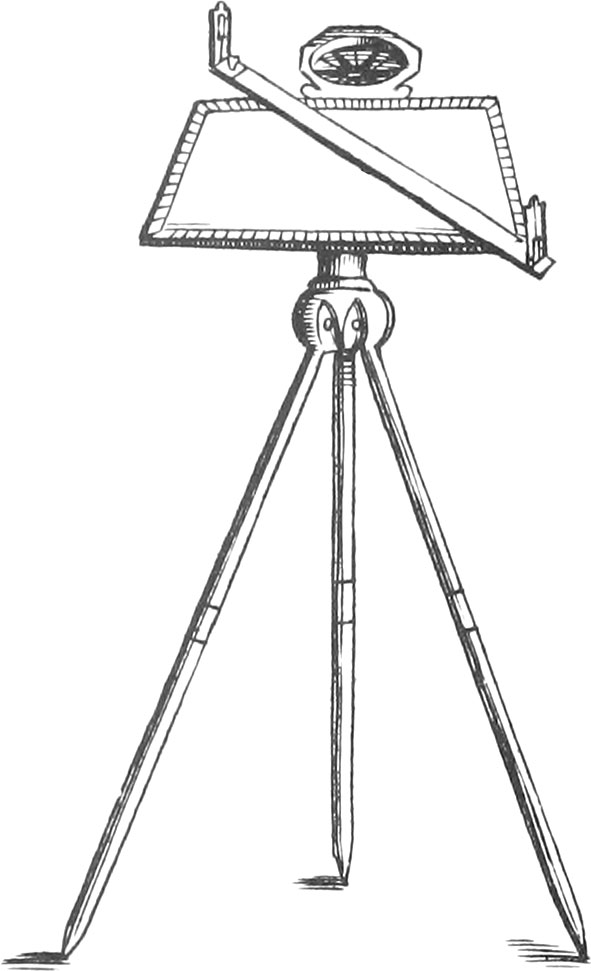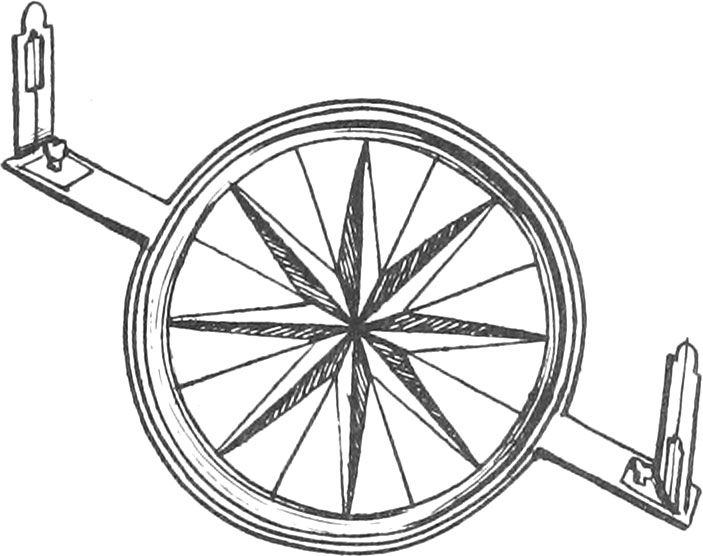The Table itself is a Parallelogram of Oak, or other Wood, about 15 Inches long, and 12 broad, consisting of two several Boards, round which are Ledges of the same Wood; the two opposite of which being taken off, and the Spangle unskrewed from the Bottom, the aforesaid two Boards may be taken asunder for ease and conveniency of Carriage. For the binding of the two Boards and Ledges fast, when the Table is set together, there is a Box Jointed-Frame, about \(\frac{3}{4}\) of an Inch broad, and of the same thickness as the Boards, which may be folded together in 6 Pieces. This Frame is so contrived, that it may be taken off and put on the Table at pleasure, and may go easily on the Table, either side being upwards. This Frame also is to fasten a Sheet of Paper upon the Table, by forcing down the Frame, and squeezing in all the Edges of the Paper; so that it lies firm and even upon the Table, that thereby the Plot of a Field, or other Inclosure, may conveniently be drawn upon it.
On both sides this Frame, near the inward Edge, are Scales of Inches subdivided into 10 equal Parts, having their proper Figures set to them. The Uses of these Scales of Inches, are for ready drawing of Parallel Lines upon the Paper; and also for shifting your Paper, when one Sheet will not hold the whole Work.
Upon one side of the said Box Frame, are projected the 360 Degrees of a Circle from a Brass Center-Hole in the Middle of the Table. Each of these Degrees are subdivided into 30 Minutes; to every 10th Degree is set two Numbers, one expressing the proper Number of Degrees, and the other the Complement of that Number of Degrees to 360. This is done to avoid the trouble of Substraction in taking of Angles.
On the other Side of this Frame, are projected the 180 Degrees of a Semi-Circle from a Brass Center-Hole, in the Middle of the Table’s length, and about a fourth Part of it’s breadth. Each of these Degrees are subdivided into 30 Minutes; to every 10th Degree is set likewise, as on the other side, two Numbers; one expressing the proper Number of Degrees, and the other the Complement of that Number of Degrees to 180, for the same Reason, as before.
The manner of projecting the Degrees on the aforesaid Frame, is, by having a large Circle divided into Degrees, and every 30 Minutes: For then placing either of the Brass Center-Holes on the Table, in the Center of that Circle so divided, and laying a Ruler from that Center to the Degrees on the Limb of the Circle; where the Edge of the Ruler cuts the Frame, make Marks for the Correspondent Degrees on the Frame.
The Degrees thus intersect on the Frame, are of excellent use in wet or stormy Weather, when you cannot keep a Sheet of Paper upon the Table. Also these Degrees will make the Plain-Table a Theodolite, or a Semi-Circle, according as what side of the Frame is upper-most.
There is a Box, with a Needle and Card, covered with a Glass, fixed to one of the long Sides of the Table, by means of a Screw, that thereby it may be taken off. This Box and Needle is very useful for placing the Instrument in the same Position upon every remove.
There belongs to this Instrument a Brass Socket and Spangle, screwed with three Screws to the Bottom of the Table, into which must be put the Head of the three-legged Staff, which may be screwed fast, by means of a Screw in the Side of the Socket.
There is also an Index belonging to the Table, which is a large Brass Ruler, at least 16 Inches long, and 2 Inches broad, and so thick as to make it strong and firm, having a sloped Edge, called the Fiducial Edge, and two Sights screwed perpendicularly on it, of the same Height. They must be set on the Ruler perfectly at the same Distance from the Fiducial Edge. Upon this Index it is usual to have many Scales of equal Parts, as also Diagonals, and Lines of Chords.








